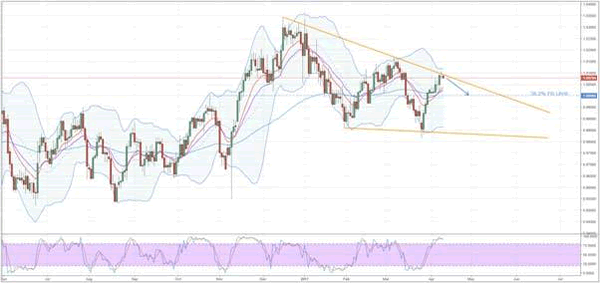Key Points:
- Long-term wedge ready to slap the USDCHF lower.
- Fundamental bias suggestive of losses moving forward.
- The pair should retreat back to parity.
The Swissy should be gearing up for another reversal in fairly short order as the technical and fundamental biases turn against the pair. Specifically, we continue to see the long-term chart pattern exert its influence and when this is coupled with a number of fundamental developments, downside risks seem to be increasing at a notable rate. As a result, let’s take a closer look at the pair to ascertain exactly what may be on offer this week.
As is shown on the daily chart, it is rather plain to see that the USDCHF has been rallying strongly over the past week or so. Additionally, if the EMA bias is anything to go by, this momentum looks to be fairly entrenched which could mean we see even further gains over the impending sessions. However, what is also becoming clear, is that a rather convincing wedge pattern is forming up which would typically indicate precisely the opposite is on the agenda for the Swissy

Indeed, the pair is challenging the upper constraint of this long-term wedge so the question is now, will we see a breakout or will the structure hold firm? From a technical point of view, there is some uncertainty about which of these two outcomes is more likely. On the one hand, the EMA bias and parabolic SAR readings are leaning towards bullish which could mean that a breakout isn’t totally impossible. Whilst, on the other hand, stochastics are overbought and the pair has drifted close to the upper Bollinger band which could be indicative of a reversal.
Taking a look at the broader fundamental environment, we have a slightly clearer image of what is likely to be the pair’s next move. Specifically, it appears that the rally was already petering out as it contended with the 100 day moving average and the last two major spikes in buying pressure are simply near-term bursts coming in response to some solid US employment data. As a result, the USDCHF may have much less underlying support than it might at first appear.
Furthermore, there is a strong case suggesting that the Franc should be taking ground back from the greenback based on its safe haven status. In particular, the US’s involvement in Syria and heightened tensions between North Korea and the entire planet dominated headlines last week and this will be bolstering interest in the CHF. Moreover, fears that the stock market is amid a bubble and in danger of correcting will see traders taking a slightly more risk-off approach, likely adding to the Franc’s buoyancy. In fact, we are already seeing the effects of these expectations creeping back into the market as the VIX is at its highest point for 2017 at around the 14.05 mark.
Overall, the forecast for the pair is skewed towards bearish which could result in some decent downside action within the next few sessions. Specifically, if a reversal is seen, the USDCHF should retreat back to parity before the 100 day EMA and the 38.2% Fibonacci level cap losses. As for where the pair moves to from there, it is currently unclear but the aforementioned support zone is by no means unbreakable. As a result, monitor the Swissy closely as these near-term downsides may only be the beginning of a sizable decline.













